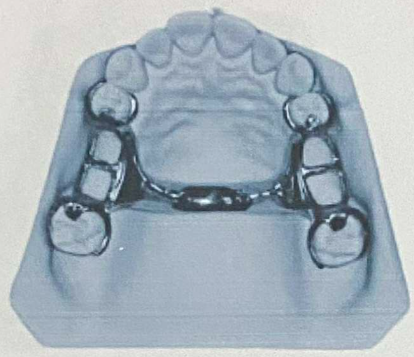MX-MN MAJOR CONNECTOR
1/63
Earn XP
Description and Tags
summarization from the book + illustrations from lab manual
Name | Mastery | Learn | Test | Matching | Spaced |
|---|
No study sessions yet.
64 Terms
indication of mandibular lingual bar
when sufficient space exists between the slightly elevated alveolar lingual sulcus and the lingual gingival tissue
characteristics of a mandibular lingual bar
Half-pear shaped with bulkiest portion inferiorly located
Superior border tapered to soft tissue
Superior border located at least 4 mm inferior to gingival margins and farther if possible
Inferior border located at the ascertained height of the alveo- lar lingual sulcus when the patient’s tongue is slightly elevated
blockout and relief requirements for a mandibular lingual bar
All tissue under- cuts parallel to the path of placement
An additional thickness of 32-gauge sheet wax when the lingual surface of the alveolar ridge is undercut or parallel to the path of placement (see Figures 11-23 and 11-24)
No relief is necessary when the lingual surface of the alveolar ridge slopes inferiorly and posteriorly
One thickness of base- plate wax over basal seat areas (to elevate minor connectors for attaching acrylic-resin denture bases).
waxing specifications for a mandibular lingual bar
Six-gauge, half-pear–shaped wax form reinforced by 22- to 24-gauge sheet wax or simi- lar plastic pattern adapted to the design width
Long bar requires more bulk than short bar; however, cross-sectional shape is unchanged.
type of finishing line used for a mandibular lingual bar
Butt-type joint(s) with minor connector(s) for retention of denture base(s).
indication of mandibular Linguoplate
when there is sufficient space between the elevated alveolar lingual sulcus and the lingual gingival tissue.
Inadequate space for rigid lingual bar.
Severe residual ridge resorption (Class I arch).
Periodontally weakened teeth needing group function.
Future incisor replacement planning.
Characteristics and Location of mandibular Linguoplate
Half-pear shaped with bulkiest portion inferiorly located
Thin metal apron extending superiorly to contact cingula of anterior teeth and lingual surfaces of involved posterior teeth at their height of contour
Apron extended interproximally to the height of contact points (i.e., closing interproximal spaces)
Scal- loped contour of apron as dictated by interproximal blockout
Superior border finished to continuous plane with con- tacted teeth
Inferior border at the ascertained height of the alveolar lingual sulcus when the patient’s tongue is slightly elevated.
Blockout and Relief of Master Cast for mandibular Linguoplate
All involved undercuts of contacted teeth parallel to the path of placement
All involved gingival crevices
Lingual surfaces of alve- olar ridge and basal seat areas the same as for a lingual bar.
Waxing Specifications for mandibular Linguoplate
Inferior border: 6-gauge, half- pear–shaped wax form reinforced with 24-gauge sheet wax or similar plastic pattern
Apron: 24-gauge sheet wax.
indication of mandibular sublingual bar
Floor of the mouth <6mm from free gingival margin.
Need to keep gingival margins of anterior teeth exposed.
Depth of floor of mouth inadequate for lingual bar
contraindication of mandibular sublingual bar
severely lingually tilted remaining anterior teeth
Characteristics and Location of mandibular sublingual bar
The sublingual bar is essentially the same half-pear shape as a lingual bar, except that the bulkiest portion is located to the lingual and the tapered portion is toward the labial. The superior border of the bar should be at least 3 mm from the free gingival mar- gin of the teeth. The inferior border is located at the height of the alveolar lingual sulcus when the patient’s tongue is slightly elevated. This necessitates a functional impression of the lingual vestibule to accurately register the height of the vestibule.
Blockout and Relief of Master Cast for mandibular sublingual bar
(1) All tissue under- cuts parallel to path of placement. (2) An additional thick- ness of 32-gauge sheet wax when the lingual surface of the alveolar ridge is undercut or parallel to the path of place- ment. (3) One thickness of baseplate wax over basal seat areas (to elevate minor connectors for attaching acrylic-resin denture bases).
Waxing Specifications for mandibular sublingual bar
(1) Six-gauge, half-pear–shaped wax form reinforced by 22- to 24-gauge sheet wax or simi- lar plastic pattern adapted to design width. (2) Long bar bulkier than short bar; however, cross-sectional shape unchanged.
Finishing Lines for mandibular sublingual bar
Butt-type joint(s) with minor connector(s) for retention of denture base(s).
Indications of a mandibular lingual bar with continuous bar (Cingulum Bar)
(1) When a linguoplate is otherwise indicated but the axial alignment of anterior teeth is such that excessive blockout of interproximal undercuts would be required. (2) When wide diastemata exist between man- dibular anterior teeth and a linguoplate would objectionably display metal in a frontal view.
characteristics and location of a mandibular lingual bar with continuous bar (Cingulum Bar)
(1) Conventionally shaped and located same as lingual bar major connec- tor component when possible. (2) Thin, narrow (3 mm) metal strap located on cingula of anterior teeth, scalloped to follow interproximal embrasures with inferior and superior borders tapered to tooth surfaces. (3) Originates bilaterally from incisal, lingual, or occlusal rests of adja- cent principal abutments.
Blockout and Relief of Master Cast of a mandibular lingual bar with continuous bar (Cingulum Bar)
(1) Lingual surfaces of alveolar ridge and basal seat areas same as for lingual bar. (2) No relief for continuous bar except blockout of interprox- imal spaces parallel to path of placement.
Waxing Specifications of a mandibular lingual bar with continuous bar (Cingulum Bar)
(1) Lingual bar major connector component waxed and shaped same as lingual bar. (2) Con- tinuous bar pattern formed by adapting two strips (3 mm wide) of 28-gauge sheet wax, one at a time, over the cingula and into interproximal embrasures.
finishing lines for a mandibular lingual bar with continuous bar (Cingulum Bar)
A: Butt-type joint(s) with minor connector(s) for retention of denture base(s).
indications of Mandibular Continuous Bar (Cingulum Bar)
When a lingual plate or sublingual bar is otherwise indicated but the axial alignment of the anterior teeth is such that excessive blockout of interproximal under- cuts would be required.
contraindications of Mandibular Continuous Bar (Cingulum Bar)
(1) Anterior teeth severely tilted to the lingual. (2) When wide diastemata that exist between the mandibular anterior teeth and the cingulum bar would objectionably display metal in a frontal view
Characteristics and Location of Mandibular Continuous Bar (Cingulum Bar)
(1) Thin, narrow (3 mm) metal strap located on cingula of anterior teeth, scalloped to follow interproximal embrasures with inferior and superior borders tapered to tooth surfaces. (2) Originates bilaterally from incisal, lingual, or occlusal rests of adjacent principal abutments.
blockout and relief done of Mandibular Continuous Bar (Cingulum Bar)
No relief for cingu- lum bar except blockout of interproximal spaces parallel to the path of placement.
waxing specifications of Mandibular Continuous Bar (Cingulum Bar)
Cingulum bar pattern formed by adapting two strips (3 mm wide) of 28-gauge sheet wax, one at a time, over the cingula and into interproximal embra- sures.
finishing lines of Mandibular Continuous Bar (Cingulum Bar)
Butt-type joint(s) with minor connector(s) for denture base retention.
Indications of Mandibular Labial Bar
(1) When lingual inclinations of remain- ing mandibular premolar and incisor teeth cannot be cor- rected, preventing placement of a conventional lingual bar connector. (2) When severe lingual tori cannot be removed and prevent the use of a lingual bar or lingual plate major connector. (3) When severe and abrupt lingual tissue under- cuts make it impractical to use a lingual bar or a lingual plate major connector.
Characteristics and Location of Mandibular Labial Bar
(1) Half-pear shaped with bulkiest portion inferiorly located on the labial and buccal aspects of the mandible. (2) Superior border tapered to soft tissue. (3) Superior border located at least 4 mm inferior to labial and buccal gingival margins and farther if possible. (4) Inferior border located in the labial-buccal vestibule at the juncture of attached (immobile) and unattached (mobile) mucosae.
Blockout and Relief of Mandibular Labial Bar
(1) All tissue undercuts parallel to path of placement, plus an additional thickness of 32-gauge sheet wax when the labial surface is undercut or parallel to the path of placement. (2) No relief necessary when the labial surface of the alveolar ridge slopes inferiorly to the labial or buccal. (3) Basal seat areas same as for lingual bar major connector.
Waxing Specifications of Mandibular Labial Bar
(1) Six-gauge, half-pear–shaped wax form reinforced with 22- to 24-gauge sheet wax or similar plastic pattern. (2) Long bar necessitates more bulk than short bar; however, cross-sectional shape unchanged. (3) Minor connectors joined with occlusal or other superior components by a labial or buccal approach. (4) Minor con- nectors for base attachment joined by a labial or buccal approach.
Finishing Lines of Mandibular Labial Bar
Butt-type joint(s) with minor connector(s) for retention of denture base(s).
Indications of Single Palatal Strap–Type Major Connector
Bilateral edentulous spaces of short span in a tooth-supported restoration.
Characteristics and Location of Single Palatal Strap–Type Major Connector
(1) Anatomic replica form. (2) Anterior border follows the valleys between rugae as nearly as possible at right angles to median suture line. (3) Posterior border at right angle to median suture line. (4) Strap should be 8 mm wide or approximately as wide as the com- bined width of a maxillary premolar and first molar. (5) Con- fined within an area bounded by the four principal rests.
Blockout and Relief of Single Palatal Strap–Type Major Connector
(1) Usually none required except slight relief of elevated medial palatal raphe or any exostosis crossed by the connector. (2) One thickness of baseplate wax over basal seat areas (to elevate minor con- nectors for attaching acrylic-resin denture bases).
Waxing Specifications of Single Palatal Strap–Type Major Connector
Anatomic replica pattern equiva- lent to 22- to 24-gauge wax, depending on arch width.
Finishing Lines of Single Palatal Strap–Type Major Connector
(1) Undercut and slightly elevated. (2) No farther than 2 mm medial from an imaginary line con- tacting lingual surfaces of principal abutments and teeth to be replaced. (3) Follow curvature of arch.
Indications of Single Broad Palatal Major Connector
(1) Class I partially edentulous arches with residual ridges that have undergone little vertical resorp- tion and will lend excellent support. (2) V- or U-shaped pal- ates. (3) Strong abutments (single or made so by splinting). (4) More teeth in arch than six remaining anterior teeth. (5) Direct retention not a problem. (6) No interfering tori.
Characteristics and Location of Single Broad Palatal Major Connector
(1) Anatomic replica form. (2) Anterior border following valleys of rugae as near right angle to median suture line as possible and not extending anterior to occlusal rests or indirect retainers. (3) Posterior border located at junction of hard and soft palate but not extended onto soft palate; at right angle to the median suture line; extended to pterygomaxillary notches.
Blockout and Relief of Single Broad Palatal Major Connector
(1) Usually none required except relief of elevated median palatal raphe or any small exostoses covered by the connector. (2) One thickness of baseplate wax over basal seat areas (to elevate minor con- nectors for attaching acrylic-resin denture bases).
Waxing Specifications of Single Broad Palatal Major Connector
Anatomic replica pattern equiva- lent to 24-gauge sheet wax thickness.
Finishing Lines of Single Broad Palatal Major Connector
(1) Provision for butt-type joint at ptery- gomaxillary notches. (2) Undercut and slightly elevated. (3) No farther than 2 mm medial from an imaginary line contacting the lingual surfaces of the missing natural teeth. (4) Following curvature of arch.
Indications of Anterior-Posterior Strap–Type Major Connector
(1) Class I and II arches in which excellent abutment and residual ridge support exists, and direct retention can be made adequate without the need for indirect retention. (2) Long edentulous spans in Class II, modification 1 arches. (3) Class IV arches in which anterior teeth must be replaced with a removable partial denture. (4) Inoperable palatal tori that do not extend posteriorly to the junction of the hard and soft palates
Characteristics and Location of Anterior-Posterior Strap–Type Major Connector
(1) Parallelogram shaped and open in center portion. (2) Relatively broad (8 to 10 mm) anterior and posterior palatal straps. (3) Lateral palatal straps (7 to 9 mm) narrow and parallel to curve of arch; minimum of 6 mm from gingival crevices of remaining teeth. (4) Ante- rior palatal strap: Anterior border not placed farther ante- riorly than anterior rests and never closer than 6 mm to lingual gingival crevices; follows the valleys of the rugae at right angles to the median palatal suture. Posterior border, if in rugae area, follows valleys of rugae at right angles to the median palatal suture. (5) Posterior palatal connector: Poste- rior border located at junction of hard and soft palates and at right angles to median palatal suture and extended to hamu- lar notch area(s) on distal extension side(s). (6) Anatomic replica or matte surface.
Blockout and Relief of Anterior-Posterior Strap–Type Major Connector
(1) Usually none required except slight relief of elevated median palatal raphe where anterior or posterior straps cross the palate. (2) One thickness of baseplate wax over basal seat areas (to elevate minor connectors for attaching acrylic-resin denture bases)
Waxing Specifications of Anterior-Posterior Strap–Type Major Connector
(1) Anatomic replica patterns or matte surface forms of 22-gauge thickness. (2) Posterior pal- atal component: A strap of 22-gauge thickness, 8 to 10 mm wide (a half-oval form of approximately 6-gauge thickness and width) may also be used.
Indications of Complete Palatal Coverage Major Connector
(1) In most situations in which only some or all anterior teeth remain. (2) Class II arch with a large posterior modification space and some missing ante- rior teeth. (3) Class I arch with one to four premolars and some or all anterior teeth remaining, when abutment sup- port is poor and cannot otherwise be enhanced; residual ridges have undergone extreme vertical resorption; direct retention is difficult to obtain. (4)
Characteristics and Location of Complete Palatal Coverage Major Connector
(1) Anatomic replica form for full palatal metal casting supported anteriorly by positive rest seats. (2) Palatal linguoplate supported anteriorly and designed for attachment of acrylic-resin extension posteri- orly. (3) Contacts all or almost all of the teeth remaining in the arch. (4) Posterior border: Terminates at the junction of the hard and soft palates; extended to hamular notch area(s) on distal extension side(s); at a right angle to median suture line.
Blockout and Relief of Complete Palatal Coverage Major Connector
(1) Usually none required except relief of elevated median palatal raphe or any small palatal exostosis. (2) One thickness of baseplate wax over basal seat areas (to elevate minor connectors for attach- ing acrylic-resin denture bases).
Waxing Specifications of Complete Palatal Coverage Major Connector
(1) Anatomic replica pattern equivalent to 22- to 24-gauge sheet wax thickness. (2) Acrylic-resin extension from linguoplate the same as for a complete denture.
indications of U-Shaped Palatal Major Connector
used only in those situations in which inoperable tori extend to the posterior limit of the hard palate.
disadvantages of U-Shaped Palatal Major Connector
the least favor- able design of all palatal major connectors because it lacks the rigidity of other types of connectors.
Anterior border placement for U-Shaped Palatal Major Connector
Keep at least 6 mm away from adjacent teeth
Prohibited support for U-Shaped Palatal Major Connector
Should never be supported, even temporarily, by inclined lingual surfaces of anterior teeth.
labial bar
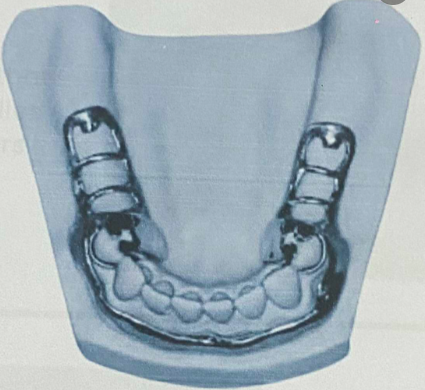
lingual bar with cingulum bar
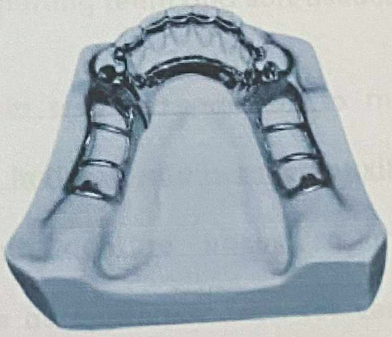
interrupted linguoplate
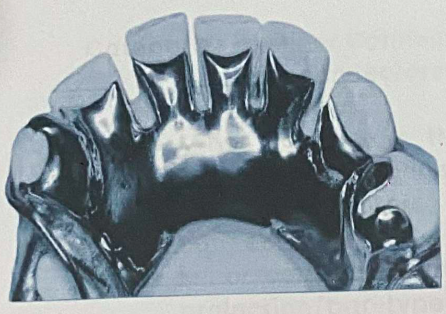
linguoplate
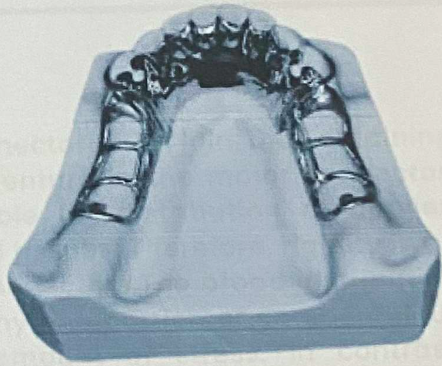
lingual bar
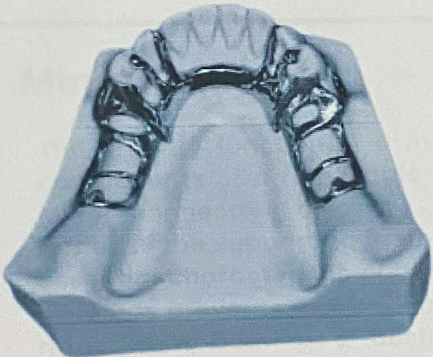
complete palatal plate

horseshoe major connector
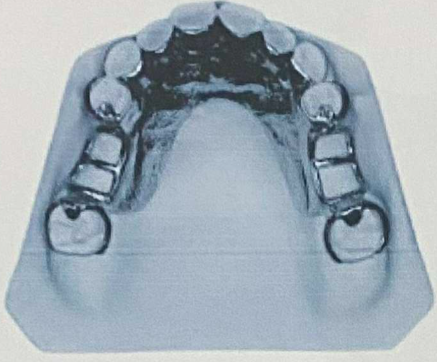
combination anterior-posterior palatal strap
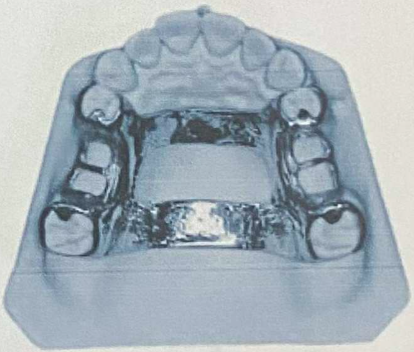
combination anterior-posterior palatal bar
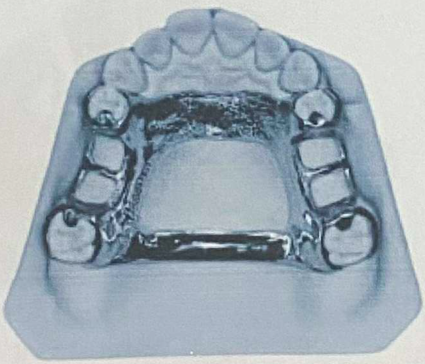
single palatal strap
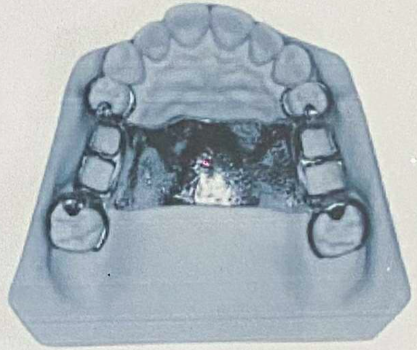
single palatal bar
